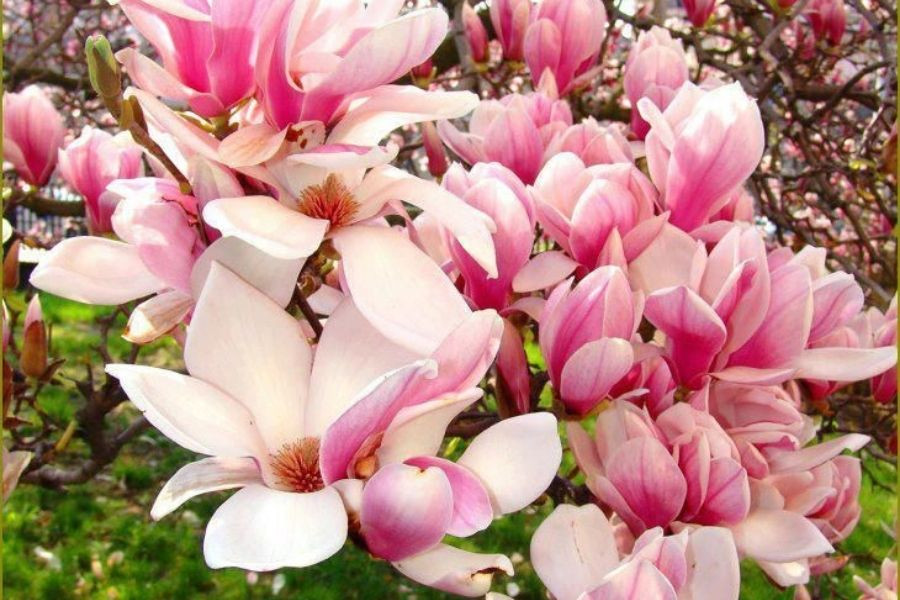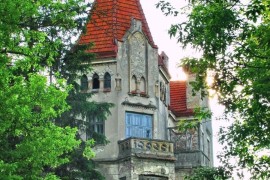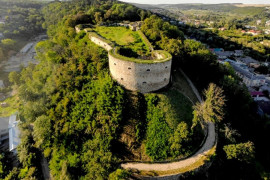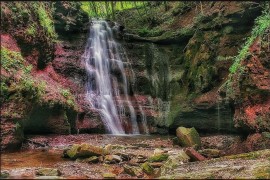At Slava cafe in Ozerna (Ternopil region). Everyone chooses their own food. Low prices and quick service.
-
 Photo
Photo -
 Map
Map














Through the Vikno to Medobory + magnolia flowering
Khorostkiv, Yabluniv, Kopychyntsi, Husiatyn, Lychkivtsi, Vikno, Hrymailiv, Mount Bohyt, reserve “Medobory”, the Zbruch River.
Tour language: Ukrainian. Contact us if you would like to hire a guide who speaks English or another foreign language.
 Tour plan
Tour planDay 1: departure from Lviv (08:00) - Ternopil (10:30) - Khorostkiv (tour of the city, the palace complex and arboretum, magnolia blossom) - Yabluniv (tour of the palace, park, churches, monuments) - Kopychyntsi (lunch, tour of the city, churches and museum) - Oryshkivtsi (relaxation in the pools and saunas of the SPA centre) - Husiatyn district (check-in to the hotel by 21:00 and dinner).
Day 2: breakfast and departure (07:00) - Husiatyn (tour of the city, churches, panorama of the Zbruch River and mineral water tasting) - Lychkivtsi (tour of the castle, church and villa, lunch) - Horodnytsia (hike to the hill fort on Mount Bogit) - Ternopil (21:30) - Lviv (return by 22:30).
 Excursion objects
Excursion objects
A small industrial town on the river Taina can boast of its enormous Palace complex of Semenskyi-Levyskyi. The most ancient landmark of the complex is the old Palace (the 1790s), and the most beautiful one is the neo-Baroque Palace (1837), built by the Italian architect Botocchini. Among the architectural attractions of Khorostkiv, we should also mention the Church of the Holy Virgin (1887), the equestrian arena (1837) and the building of the railway station (1890). Nature lovers will find a monument of landscape art of the national importance -Khorostkiv arboretum (1972) which occupies the area of 18 hectares and contains more than 1,500 species of flora from all continents.
Famous for its apple gardens, the village on the river Nichlava welcomes you to explore the modest Didushytskyi's Palace (XIX century), surrounded by a park with exotic plants (the 1840s). Its highlights are a beech alley and a pond with a picturesque island. The Church of the Assumption of the Blessed Virgin Mary (1875) and the Church of St. Elizabeth (1900) in Yabluniv are also worth seeing.
Known for its sausages, this Podilian town, located like Rome on seven hills, is also famous for its ancient wooden Church of the Exaltation of the Holy Cross (1630). Also, in Kopychyntsi there is a fascinating secession area of the Market square, the Church of the Assumption of the Virgin Mary (1802), a Ukrainian People's House (1910), a synagogue (XVIII century), the Church of the Nativity of the Virgin (1898) and Mykolai's Church (1900.), designed by an architect Vasyl Nahirnyi. Kopychyntsi is well-known in Ukraine for its Amateur Folk Theatre named after B. Lepkyi. You can learn about its glorious past and present in the Museum of Theatrical Arts of the Ternopil region.
Husiatyn region has long been famous for its highly mineralized healing waters, and you can improve your health in the modern SPA center, which operates at the hotel and restaurant complex "Orysia". Here you can take a dip in the three whirlpool pools with healing brine, bask in the sauna with Himalayan salt, relax in the Turkish hammam and swim in the large swimming pool with plain water. Mineral water is extracted from a well 770 meters deep in the Novozbruchanskoye deposit and contains a huge amount of useful microelements, and the salt content is twice as high as in seawater.
The homeland of the Cossack leader Severyn Nalyvaiko has long been famous for its highly mineralized hydrogen sulphide therapeutic water, such as "Naftusia”, which is popularly called "ropa”. You can taste it as well as take with yourself. The river Zbruch surrounds the town from three sides and separates it from the village with the same name in the Khmelnytskyi region. Among the architectural and historical monuments, which you should visit, are the Church of St. Onuphrius (XVI century), the Church of St. Anthony (1610), the Bernardine monastery and the ruins of the synagogue (XVII century), built in the Gothic-Moorish style. You can learn about the glorious history of the region in the museum of local lore. Due to climate change, on the generous Podilian land now there are grape plantations, where they produce fine wine for its connoisseurs.
Near the village in the river Zbruch in 1848, the border guards found Zbruch idol –Svitovyd, which is now a highlight of the Krakow archaeological museum.
On a high hill in the middle of the village, there is a number of buildings and monuments that may interest tourists, namely, the ruins of the defensive Church of the Conception of the Virgin Mary (1728), the chapel built on the site of the castle and its remains (XVII century), the tombstone of M. Zaborovskyi (1828), the cholera column (1831) and a lovely villa of Timelman (early XX century) built in the style of Romanticism with Gothic elements.
We invite you to take a hike through the virgin forests to the former oceanic reef mountain Bogit (also known as Bohit, Bogit, Bohut), which is a very valuable part of the Medobory Nature Reserve due to its rich and rare vegetation. This rather high Tovtra is a classic rocky limestone ridge 414 metres above sea level, which has long been a cult centre for people. Scientists have found here an ancient Slavic pagan hill fort (IX-XIII centuries), burial mounds, an old road from the Scythian era, a system of ramparts and ditches from the Scythian and Old Slavic periods. The prehistoric dolmen structure, consisting of two vertical blocks of stone and one horizontal slab laid on top of them, is particularly fascinating. Some scholars believe that the legendary Zbruch idol, Svitovit, which was found in the Zbruch River, stood on Mount Bogit, and this place is the Zbruch pagan cult centre, which operated long after the adoption of Christianity in our lands.
 Finances
Finances- travel by comfortable bus;
- travel guide;
- excursions at travel attractions;
- travel insurance;
- accommodation.
- entrance tickets to tourist sites;
- meals.
- Children 6 years old and younger, accompanied by 2 adults, without a separate seat on the coach and accommodation – free of charge
- Children from 7 to 12 years old and people with disabilities (1st and 2nd groups with a certificate): 120 UAH / person (from the total cost of the tour)
- ATO participants (at the presence of a certificate): discount 30% from the cost of the tour
 Entrance tickets
Entrance tickets
Museum of Theatre Art in Kopychyntsi: general, pension - 10 UAH/person, student - 8 UAH/person, pupils - 5 UAH/person.
SPA center in Oryshkivtsi: (up to 2 hours): 300 UAH
Ecological and educational trail ‘To Mount Bohit’ in the Medobory Nature Reserve: general, pensioners - 45 UAH/person, students, pupils - 15 UAH/person, children under 10 years old - free.
 Technical information about the ecological and educational trail ‘To Mount Bogit’
Technical information about the ecological and educational trail ‘To Mount Bogit’
- The length of the route from Horodnytsia village to Mount Bohit and back is 6.2 km, with an altitude difference of 180 metres;
- The total duration of the route (ascent and descent) is 3.5-4.5 hours;
- The route is designed for an average group of physically healthy people;
- Participation does not require prior training or experience;
- Please wear comfortable shoes and clothes for the hike, as the route passes through forests and bushes.
- The walking route is optional. Those who do not wish to participate can take a walk around the surroundings of the picturesque village of Horodnytsia.
 Accommodation
Accommodation2, 3 and 4-bed rooms with amenities in the room.
 Food
FoodIt takes place in the cafe ‘Bilka’ in Kopychynka. Kopychyntsi. Menu: soup with meatballs, mamalyga with bacon and cutlet, cabbage salad, bread, tea. The cost is 110 UAH per person.
takes place in the hotel restaurant. Menu: vesnianyi salad (cucumber, tomato, pepper, cabbage, oil), French-style potatoes with meat, raspberry compote. The price is 95 UAN/person.
takes place in the hotel restaurant. Menu: buckwheat, sausage, vegetable salad, croissant, tea, bread. The cost is 85 UAN/person.
It takes place in the estate ‘On the edge of Medobory’, Lychkivtsi village. Menu: Korean carrot salad, borsch, stuffed cabbage, bread, tea, pancakes. Price: 95 UAH per person.
At Slava cafe in Ozerna (Ternopil region). Everyone chooses their own food. Low prices and quick service.
Hotel "Lviv", 7 V. Chornovola Ave
18, S. Budnoho St.; Ternopil (Petrykiv)
 Questions and answers
Questions and answers
Можна двома шляхами:
а) подивитися у нас на сайті (біля дат).
б) дізнатися у менеджера через онлайн-консультацію сайту, Skype, електронною поштою або по телефону (усі контактні телефони є на сторінці "Контакти");
*приклад
![]() вільних місць немає.
вільних місць немає.
![]() вільні місця 2-10 осіб.
вільні місця 2-10 осіб.
![]() вільних місць більше 10ти.
вільних місць більше 10ти.
Вхідні квитки і харчування Ви оплачуєте в автобусі керівнику групи. Екскурсії і харчування не є обов’язковими, Ви обираєте тільки те, що бажаєте.
У разі відмови від заброньованого туру просимо завчасно повідомити про це відповідального менеджера по телефону або на електронну пошту.
Умови повернення оплати за анульовані місця залежать від терміну повідомлення про анулювання:
- не пізніше ніж за 7 робочих днів до початку туру - повертаємо 85 % вартості;
- від 6 до 4 робочих днів до початку туру - повертаємо 50 % вартості;
- від 3 до 2 робочих днів до початку туру - повертаємо 20 % вартості;
- менше ніж за 1 робочий день до початку туру, а також при неявці туриста - оплату не повертаємо та не переносимо цю оплату на іншу дату виїзду чи на інший тур.
У Новорічних, Різдвяних та акційних турах умови анулювання можуть відрізнятися від стандартних (з цими умовами можна ознайомитись у Правилах бронювання).
Анулювання турів закордон.
Правила анулювання турів закордон туристом.
Умови повернення оплати за скасовані місця залежать від терміну повідомлення про анулювання:
- не пізніше, ніж за 15 робочих днів до початку туру - повертаємо 100 % вартості туру або переносимо 100% на іншу дату чи тур;
- від 14 до 7 робочих днів до початку туру - повертаємо 50 % вартості туру;
- від 6 до 4 робочих днів до початку туру - повертаємо 20 % вартості туру;
- менше, ніж за 3 робочих дні до початку туру, а також при неявці - оплату не повертаємо та не переносимо цю оплату на іншу дату виїзду чи на інший тур.
Інфо-лист з контактами керівника групи, адресою місця виїзду та іншою інформацією про тур надсилається на електронні пошти турагентів або у вайбер туристів не пізніше ніж за 1-2 календарні дні до виїзду (залежно від тривалості туру). Тому якщо до виїзду залишилось 4 і більше днів, то можливо ми ще не встигли надіслати інфо-лист. Також крім папки «Вхідні», наші листи можуть потрапляти у папку «СПАМ». Тому перевірте, будь ласка, цю папку. У випадку, якщо інформаційного листа немає і там, просимо сконтактуватись з нами по телефону. Можливо, у нас неправильно зазначена Ваша електронна адреса або помилка у номері телефону.
Місця в автобусі бронюються згідно запису. Чим швидше Ви забронюєтесь, тим ближче до переду автобуса зможете сісти.
Умови проживання залежать від обраного Вами туру. Усі деталі щодо поселення, чітко розписані у інформаційних листах.
Проживання під час мандрівки відбувається у 2- і 3-місних номерах. Якщо Ви подорожуєте наодинці, то Вас можуть поселити з кимось із туристів (підселення не відбувається до туристів протилежної статі). Також Ви можете проживати самі в окремому номері за додаткову оплату (ціну уточнювати в менеджера цього туру).
З собою у мандрівку ми рекомендуємо брати посвідчення особи (паспорт, водійські права, свідоцтво про народження тощо). Усі інші деталі стосовно того, що потрібно мати з собою ми зазначаємо у інформаційних листах.
Не рекомендуємо так робити. Виїзд відбувається за розкладом, оскільки тури мають насичену екскурсійну програму, для повноцінного виконання якої ми маємо дотримуватись наперед визначених часових меж. Тому радимо при купівлі квитків на поїзд (або автобус чи літак) обов'язково враховувати запас часу, який буде необхідний, щоб дістатись з вокзалу до місця збору групи та у зворотному напрямку після завершення туру. Також нагадуємо, що ми не гарантуємо швидше повернення, аніж зазначено в описі туру на сайті та не несемо відповідальності за придбання квитків на поїзд чи інший вид транспорту, у яких час відбуття або прибуття не збігається з часовими межами туру.
Так, звичайно. У нас є 2 види сертифікатів: на конкретну суму і на певний тур. Замовити їх Ви можете за офісним телефоном або безпосередньо у нас в офісі. Також замовлення можна зробити онлайн на сторінці "Подарунковий сертифікат". Після он-лайн замовлення менеджер зконтактується з Вами і уточнить деталі замовлення. Сертифікат можемо відправити службою доставки (переважно «Новою поштою») у будь-який куточок України. Бланк сертифікату є безкоштовним, оплачується лише вартість обраних послуг.
У вартість зазвичай ВХОДИТЬ (якщо інше не передбачено описом туру): проїзд комфортабельним автобусом, проживання, супровід гіда-екскурсовода, екскурсійне обслуговування в туристичних об’єктах, страхування на час подорожі.
Окремо Ви зазвичай оплачуєте вартість вхідних квитків і харчування (якщо інше не передбачено описом туру).
Надання відповіді про наявність вільних місць та підтвердження бронювання здійснюється упродовж 1 робочого дня з моменту подання запиту (крім суботи та неділі, а також державних вихідних).
Оплатити замовлення можна в нашому офісі за адресою: м. Львів, вул. Замарстинівська, 34 або банківським переказом (банківські реквізити надсилаємо за вимогою). Замовлення потрібно оплатити упродовж 3 робочих днів від моменту підтвердження (у випадку замовлення пізніше ніж за 3 дні до виїзду термін оплати узгоджується окремо).При оплаті на банківський рахунок потрібно упродовж 4 робочих годин повідомити електронною поштою відповідального менеджера про проведену оплату, вказавши при цьому назву та дати туру, прізвища замовників, суму та час оплати.
Ні, на жаль, не можна. Ми працюємо за 100% передоплатою.
 Testimonials (1)
Testimonials (1)
 Tour Manager
Tour Manager  Testimonials
Testimonials
Шановні , Відвідай. Ваша фотогалерея не відповідає задекларованим назвам. Впорядкуйте, будь ласка. Неможливо повністю...
Шановні , Відвідай. Ваша фотогалерея не відповідає задекларованим назвам. Впорядкуйте, будь ласка. Неможливо повністю осягнути всю картину подорожі.
Similar tours
Khorostkiv, Yabluniv, Kopychyntsi, Husiatyn, Lychkivtsi, Vikno, Hrymailiv, Mount Bohyt, reserve “Medobory”, the Zbruch River. Tour language: Ukrainian. Contact us if you would like to hire a guide who speaks English or another foreign language. Більше
5 castles: Mykulyntsi, Skalat, Sydoriv, Budaniv, Pidhora, Terebovlia, SPA in Oryshkivtsi, impressive viaduct and tasting local beer and wine. Більше
See the attractions of Buchach and nearby towns, Badeni Palace, and get to know the culture of Lemkos at an open-air museum. Більше
Through the Vikno to Medobory + magnolia flowering
Khorostkiv, Yabluniv, Kopychyntsi, Husiatyn, Lychkivtsi, Vikno, Hrymailiv, Mount Bohyt, reserve “Medobory”, the Zbruch River.
Tour language: Ukrainian. Contact us if you would like to hire a guide who speaks English or another foreign language.



